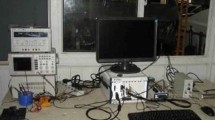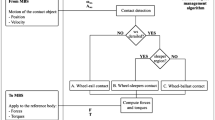Abstract
Creating a mathematical model of a vehicle crash is a task which involves considerations and analysis of different areas which need to be addressed because of the mathematical complexity of a crash event representation. Therefore, to simplify the analysis and enhance the modeling process, in this work, a brief overview of different vehicle crash modeling methodologies is proposed. The acceleration of a colliding vehicle is measured in its center of gravity—this crash pulse contains detailed information about vehicle behavior throughout a collision. A virtual model of a collision scenario is established in order to provide an additional data set further used to evaluate a suggested approach. Three different approaches are discussed here: lumped parameter modeling of viscoelastic systems, data-based approach taking advantage of neural networks and autoregressive models and wavelet-based method of signal reconstruction. The comparative analysis between each method’s outcomes is performed and reliability of the proposed methodologies and tools is evaluated.
Similar content being viewed by others
References
Eskandarian A, Marzougui D, Bedewi NE (1997) Finite element model and validation of a surrogate crash test vehicle for impacts with roadside objects. Technical report, National Crash Analysis Center, Virginia, USA
Tenga TL, Chang FA, Liu YS, Peng CP (2008) Analysis of dynamic response of vehicle occupant in frontal crash using multibody dynamics method. Math Comput Model 48(11–12):1724–1736
Kim HS, Kang SY, Lee IH, Park SH, Han DC (1996) Vehicle frontal crashworthiness analysis by simplified structure modeling using nonlinear spring and beam elements. Int J Crashworthiness 2(1):107–118
Niu Y, Shen W, Stuhmiller JH (2007) Finite element models of rib as an inhomogeneous beam structure under high-speed 11 impacts. Med Eng Phys 29(7):788–798
Moumni Z, Axisa F (2004) Simplified modelling of vehicle frontal crashworthiness using a modal approach. Int J Crashworthiness 9(3):285–297
Borovinsek M, Vesenjak M, Ulbin M, Ren Z (2007) Simulation of crash tests for high containment levels of road safety barriers. Eng Fail Anal 14(8):1711–1718
Soto CA (2004) Structural topology optimization for crashworthiness. Int J Crashworthiness 9(3):277–284
Belytschko T (1992) On computational methods for crashworthiness. Comput Struct 42(2):271–279
Deb A, Srinivas KC (2008) Development of a new lumped parameter model for vehicle side-impact safety simulation. In: Proceedings of the Institution of Mechanical Engineers, Part D: Journal of Automobile Engineering, vol. 222, pp.1793–1811
Jonsén P, Isaksson E, Sundin KG, Oldenburg M (2009) Identification of lumped parameter automotive crash models for bumper system development. Int J Crashworthiness 14(6):533–541
Šušteršić G, Grabec I, Prebil I (2007) Statistical model of a vehicle-to-barrier collision. Int J Impact Eng 34(10):1585–1593
Elmarakbi AM, Zu JW (2006) Crash analysis and modeling of two vehicles in frontal collisions using two types of smart front-end structures: an analytical approach using IHBM. Int J Crashworthiness 11(5):467–483
Pawlus W, Karimi HR, Robbersmyr KG (2011) Mathematical modeling of a vehicle crash test based on elasto-plastic unloading scenarios of spring–mass models. Int J Adv Manuf Technol 55:369–378
Pawlus W, Karimi HR, Robbersmyr KG (2011) Development of lumped-parameter mathematical models for a vehicle localized impact. J Mech Sci Technol 25(7):1737–1747
Pawlus W, Karimi HR, Robbersmyr KG (2011) Effects of different spring–mass model elasto-plastic unloading scenarios on the vehicle crash model fidelity. ICIC Expr Lett Part B Appl 2(4):757–764
Pawlus W, Karimi HR, Robbersmyr KG (2011) Application of viscoelastic hybrid models to vehicle crash simulation. Int J Crashworthiness 16(2):195–205
Pawlus W, Robbersmyr KG, Karimi HR (2011) Mathematical modeling and parameters estimation of a car crash using data-based regressive model approach. Appl Math Model 35:5091–5107
Ma J, Kockelman KM, Damien P (2008) A multvariate Poisson-lognormal regression model for prediction of crash counts by severity, using Bayesian methods. Accid Anal Prev 40(3):964–975
Pawlus W, Karimi HR, Robbersmyr KG (2012) Data-based modeling of vehicle collisions by nonlinear autoregressive model and feedforward neural network. Inf Sci. doi:10.1016/j.ins.2012.03.013, ISSN: 0020-0255
Connor JT, Martin RD, Atlas LE (1994) Recurrent neural networks and robust time series prediction. IEEE Trans Neural Netw 5(2):240–254
Crucianu M, Uhry Z, Boné R, Asselin de Beauville J-P NAR time-series prediction: a Bayesian framework and an experiment. Proceedings of the European Symposium on Artificial Neural Networks (ESANN ‘98), Bruges, Belgium, April 1998
Wang D, Lum K-Y, Yang G (2002) Parameter estimation of ARX/NARX model: a neural network based method. Proceedings of the 9th International Conference on Neural Information Processing (ICONIPOZ), Singapore
Yang G, Lin Y, Bhattacharya P (2010) A driver fatigue recognition model based on information fusion and dynamic Bayesian network. Inf Sci 180(10):1942–1954
Pham HT, Tran VT, Yang B-S (2010) A hybrid of nonlinear autoregressive model with exogenous input and autoregressive moving average model for long-term machine state forecasting. Expert Syst Appl 37(4):3310–3317
Zvejnieks G, Kuzovkov VN, Dumbrajs O, Degeling AW, Suttrop W, Urano H, Zohm H (2004) Autoregressive moving average model for analyzing edge localized mode time series on Axially Symmetric Divertor Experiment (ASDEX) Upgrade tokamak. Phys Plasmas 11(12):5658–5667
Basso M, Giarré L, Groppi S, Zappa G (2005) NARX models of an industrial power plant gas turbine. IEEE Trans Control Syst Technol 13(4):599–604
Zemouri R, Gouriveau R, Zerhouni N (2010) Defining and applying prediction performance metrics on a recurrent NARX time series model. Neurocomputing 73(13–15):2506–2521
Crone SF, Kourentzes N (2010) Feature selection for time series prediction—a combined filter and wrapper approach for neural networks. Neurocomputing 73(10–12):1923–1936
Sheta AF, Jong KD (2001) Time-series forecasting using GA-tuned radial basis functions. Inf Sci 133(3–4):221–228
Gandhi UN, Hu SJ (1995) Data-based approach in modeling automobile crash. Int J Impact Eng 16(1):95–118
Bock J, Hettenhausen J (2012) Discrete particle swarm optimisation for ontology alignment. Inf Sci 192:152–173
Karimi HR, Robbersmyr KG (2011) Signal analysis and performance evaluation of a vehicle crash test with a fixed safety barrier based on Haar wavelets. Int J Wavelets Multiresolution Image Process 9(1):131–149
Karimi HR, Pawlus W, Robbersmyr KG (2012) Signal reconstruction, modeling and simulation of a vehicle full-scale crash test based on Morlet wavelets. Neurocomputing 93:88–99, ISSN: 0925-2312
Gan M, Peng H, Peng X, Chen X, Garba I (2010) A locally linear RBF network-based state-dependent AR model for nonlinear time series modeling. Inf Sci 180(no.22):4370–4383
Mitrakis NE, Theocharis JB (2012) A diversity-driven structure learning algorithm for building hierarchical neuro-fuzzy classifiers. Inf Sci 186(1):40–58
McFadden J, Yang WT, Durrans RS (2001) Application of artificial neural networks to predict speeds on two-lane rural highways. Transp Res Rec 1751:9–17
Abedelwahab H, Abdel-Aty MA (2001) Development of artificial neural networks models to predict driver injury severity in traffic accidents at signalized intersections. Transportation Research Board 80th annual meeting, Washington D.C., USA
Várkonyi-Kóczy AR, Rövid A, Várlaki P Intelligent methods for car deformation modeling and crash speed estimation. The 1st Romanan–Hungarian Joint Symposium on Applied Computational Intelligence, Timisoara, Romania, May 2004
Syrris V, Petridis V (2011) A lattice-based neuro-computing methodology for real-time human action recognition. Inf Sci 181(10):1874–1887
van der Laan E, Veldpaus F, de Jager B, Steinbuch M LPV modeling of vehicle occupants. 9th International Symposium on Advanced Vehicle Control (AVEC '08), Kobe, Japan, October 2008
Zhang L, Shi P (2008) L 2−L ∞ model reduction for switched LPV systems with average dwell time. IEEE Trans Autom Control 53(10):2443–2448
Zhang L, Cui N, Liu M, Zhao Y (2011) Asynchronous filtering of discrete-time switched linear systems with average dwell time. IEEE Trans Circ Syst I Regular Pap 58(5):1109–1118
Zhao Y, Zhang L, Shen S, Gao H (2010) Robust stability criterion for discrete-time uncertain Markovian jumping neural networks with defective statistics of modes transition. IEEE Trans Neural Netw 22(1):164–170
Cheng Z, Pilkey WD, Darvish K, Hollowell WT, Crandall JR (2001) Correlation analysis of automobile crash responses using wavelets. Proceedings of the International Modal Analysis Conference IMAC, Kissimmee, Florida, USA
Cheng Z, Pellettiere JA, Rizer AL (2004) Wavelet-based validation methods and criteria for finite element automobile crashworthiness modeling. Proceedings of the 22nd IMAC Conference and Exposition (IMAC XXII): A Conference and Exposition on Structural Dynamics, Dearborn, MI, USA
Kankar PK, Sharma SC, Harsha SP (2011) Rolling element bearing fault diagnosis using wavelet transform. Neurocomputing 74(10):1638–1645
Hester D, Gonzalez A (2012) A wavelet-based damage detection algorithm based on bridge acceleration response to a vehicle. Mech Syst Signal Process 28:145–166
Nguyen KV, Tran HT (2010) Multi-cracks detection of a beamlike structure based on the on-vehicle vibration signal and wavelet analysis. J Sound Vib 329(21):4455–4465
Wanga YS, Leeb C-M, Kimb D-G, Xua Y (2007) Sound quality prediction for non-stationary vehicle interior noise based on wavelet pre-processing neural network model. J Sound Vib 299(4–5):933–947
Chatterjee P, OBrien E, Li Y, Gonzalez A (2006) Wavelet domain analysis for identification of vehicle axles from bridge measurements. Comput Struct 84(28):1792–1801
Sun T, Pei H, Pan Y, Zhang C (2011) Robust wavelet network control for a class of autonomous vehicles to track environmental contour line. Neurocomputing 74(17):2886–2892
Qiao Y-L, Zhao C-H, Song C-Y (2009) Complex wavelet based texture classification. Neurocomputing 72(16–18):3957–3963
Srinivasan D, Jin X, Cheu RL (2005) Adaptive neural network models for automatic incident detection on freeways. Neurocomputing 64:473–496
Liu P (2009) A self-organizing feature maps and data mining based decision support system for liability authentications of traffic crashes. Neurocomputing 72(13–15):2902–2908
Robbersmyr KG (2004) Calibration test of a standard Ford Fiesta 1.1l, model year 1987, according to NS-EN 12767. Technical Report 43/2004, Agder Research, Grimstad
Huang M (2002) Vehicle crash mechanics. CRC Press, Boca Raton
ISO 6487:2000. Road vehicles—measurement techniques in impact tests—instrumentation
Chon KH, Cohen RJ (1997) Linear and nonlinear ARMA model parameter estimation using an artificial neural network. IEEE Trans Biomed Eng 44(3):168–174
Vien NA, Yu H, Chung TC (2011) Hessian matrix distribution for Bayesian policy gradient reinforcement learning. Inf Sci 181(9):1671–1685
Nasoz F, Lisetti CL, Vasilakos AV (2010) Affectively intelligent and adaptive car interfaces. Inf Sci 180(20):3817–3836
Guo ZX, Wong WK, Li M (2012) Sparsely connected neural network-based time series forecasting. Inf Sci 193:54–71
Mendrok K (2010) Signal analysis and identification—lectures. AGH University of Science and Technology, Kraków
Grossman A, Morlet J (1984) Decomposition of Hardy functions into square integrable wavelets of constant shape SIAM. J Math Anal 15(4):723–736
Burrus CS, Gopinath RA, Guo H (1998) Introduction to wavelets and wavelet transforms. Prentice Hall, Upper Saddle River
Scargle JD, Steiman-Cameron T, Young K, Donoho DL, Crutchfield JP, Imamura J (1993) The quasi-periodic oscillations and very low frequency noise of Scorpius X-1 as transient chaos—a dripping handrail? Astrophys J Part 2 Lett 411(no.2):91–94
Misiti M, Misiti Y, Oppenheim G, Poggi J-M (2002) Wavelet Toolbox for use with MATLAB®—user’s guide, ver. 2. The MathWorks Inc
Lin J, Qu L (2000) Feature extraction based on morlet wavelet and its application for mechanical fault diagnosis. J Sound Vib 234(1):135–148
Author information
Authors and Affiliations
Corresponding author
Rights and permissions
About this article
Cite this article
Pawlus, W., Karimi, H.R. & Robbersmyr, K.G. Investigation of vehicle crash modeling techniques: theory and application. Int J Adv Manuf Technol 70, 965–993 (2014). https://doi.org/10.1007/s00170-013-5320-3
Received:
Accepted:
Published:
Issue Date:
DOI: https://doi.org/10.1007/s00170-013-5320-3




